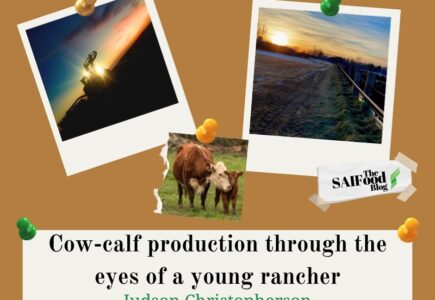The story of a sector through the eyes of a young rancher
Not Just a Salad Dressing
When I refer to ranch, some may think of salad, others of chicken wings, and likely very few would think of cow-calf production. However, cow-calf operations in western Canada, commonly referred to as ranches, are some of the most diverse, expansive, and sustainable businesses on the planet.
Being a young cow-calf producer, I have been exposed to the diversity in our sector, on our ranch, and within the production cycle. Ranches are expansive, with individual operations covering hundreds, thousands, or even tens of thousands of acres of grassland and cropland throughout the province. The livestock industry has been characterized by contraction and consolidation in recent years as the workload and profit margins characterized by crop production become desirable relative to rearing livestock.
While much of the public may not be aware of the benefits from livestock production, ranches are environmentally sustainable under proper management. This is because livestock can serve to regenerate degraded land, increase soil carbon sequestration through grazing, and provide a vast number of ecosystem services through forage production. Agricultural systems used for beef cattle sustenance can complete nutrient cycles and provide habitats for wildlife, pollinators, and millions of species that operate below the earth’s surface, ensuring healthy soils for generations to come. In short, livestock production improves biodiversity.
There is a growing disconnect between the general public and primary agriculture production, with the potential for stark consequences for the agriculture industry if this knowledge gap is not addressed. As such, the purpose of this blog is to introduce readers to a typical production cycle in the Saskatchewan cow-calf industry, providing entry-level information on the diversity characterizing the industry today.
A Diverse Production Cycle
Retrospectively, the first memories of my childhood are spending days in the cab of a tractor with my grandfather during haying season. Today, you will still find my grandfather on our family ranch at 79 years of age, waking up each morning and working alongside my father and I. Diversity: three generations with a decision-making role within a business creates a wide range of opinions, from innovative (and possibly naïve) ideas to established principles that have not be altered for decades. Debates over coffee are rarely dull.
As ranchers we all do the same thing, but we rarely do it in the same way as our neighbors. Each of us takes utmost responsibility for the wellbeing of our animals, stewardship of our land, and the protection of natural resources. However, when it comes to carrying out the production cycle, everyone has their own view on what works best from an economic, environmental, and lifestyle standpoint. On our ranch, production cycles vary by year however the typical production cycle contains four main seasons: calving and branding, haying and breeding, weaning, and winter-feeding. The average cow-calf herd in Canada contains approximately 70 breeding females; at the time of writing, our herd consists of over 900 breeding females, making for long ‘seasons’ on the ranch. Typically, there is enough time to enjoy a coffee or barley-based beverage between seasons, and little more.
Spring
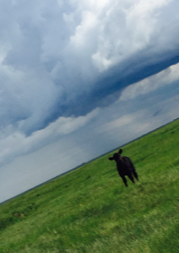
(Credit: Judson Christopherson)
Calving and branding mark the beginning of the production cycle. During calving, ranchers often assist in the delivery of calves when a cow is unable to birth it herself. This is especially the case with two-year old cows having their first calf. New calves are born, vaccinated, tagged, and branded before being sent off to summer pasture alongside their mother. These are all necessary steps to prevent disease, infection, or theft throughout the summer grazing season. While cattle rustling is featured in many Western movies, the reality is that cattle are still stolen from farms today. On our operation calving runs from mid-April into late May, with branding continuing until July.
Summer
Next, comes ‘haying season’ as preserved forages must be produced to sustain cattle herds throughout the long winters that, in many instances, would prove deleterious for cattle without the provision of a feed source. Concurrently, bulls are placed with our cattle on July 10th each year for a period of eight weeks, to ensure calves come at the correct time the following season. On our ranch, we produce dry hay, haylage, silage bales, greenfeed, and straw to maintain our cattle throughout the winter months, often amassing more than 7,000 bales in a single season. Subsequently, these bales must be transported to a central location prior to the beginning of the winter-feeding period.
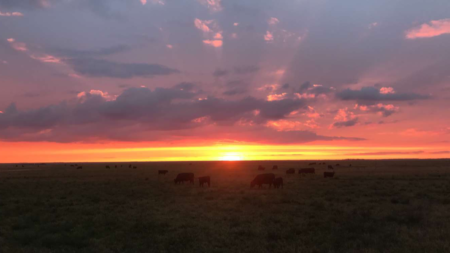
(Credit: Judson Christopherson)
Fall
Between haying season and winter feeding is weaning time, when calves are separated from their mothers at the end of October. The steer calves, or those who were bulls prior to being castrated, weigh approximately 575 pounds at this point, with heifers being about 50 pounds lighter. On our operation the steer calves are often sold at this point, with the heifers being retained and fed throughout the winter in our yard. In the beef industry, this time period is called the ‘fall run’ as the vast majority of producers sell their calf-crop between October and December each year.
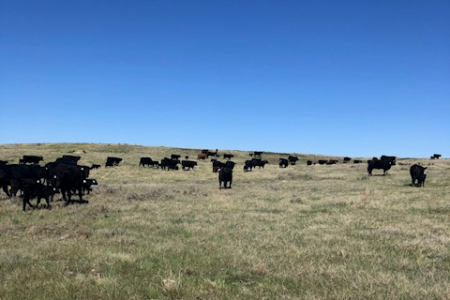
(Credit: Judson Christopherson)
This is mainly biologically driven, as most producers calve in the early months of the year, so calves are ready for weaning by fall. Retaining these animals may not be profitable or feasible in an industry where feed costs are high and margins are low, so many elect to sell in the fall. However, if demand is not strong during the peak marketing season, prices can be low and cow-calf sector profitability may be dampened as producers have little choice but to market for logistical or cash flow reasons.
Winter
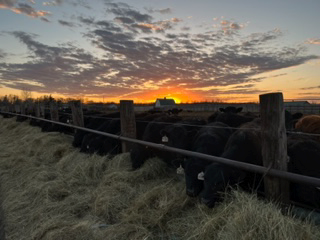
(Credit: Judson Christopherson)
Feeding periods average around 200 days in Saskatchewan, with animals requiring feed every day from early November to mid-May in many feeding systems. It is not Christmas morning on a ranch until someone remarks, “the cows don’t know it’s Christmas, time to go” in rallying everyone off the couch to begin the day’s chores. Another common motto as the days shorten is “start in the dark so you don’t have to finish in the dark” as feeding often begins well before the sun in the months of December and January. Often this involves (hopefully) starting three or four diesel engines each day and continuing until every bovine mouth is fed, regardless of what the day throws at us. Frozen watering bowls, equipment breakdowns, or two feet of snow are just a few of things that can complicate a day on the ranch, taking all day to feed the cattle on some days. Those unfamiliar with cow-calf production may think this is a complaint however, I assure you it is not. Cow-calf producers are passionate about what they do and although we may not enjoy what we do every day, we find gratification in our efforts at some point and continue onward to another season.
Concluding Remarks
No two days are the same on a cow-calf ranch, and many ranchers would not wish for anything else. Each day brings a new challenge, each week a new task, and each month a new job description entirely. I hope this blog has familiarized you with an industry that seemed foreign or secretive before you read this. It is not matter of trying to hide what we do as producers rather no one decides that today they will be the one to tell the story.


